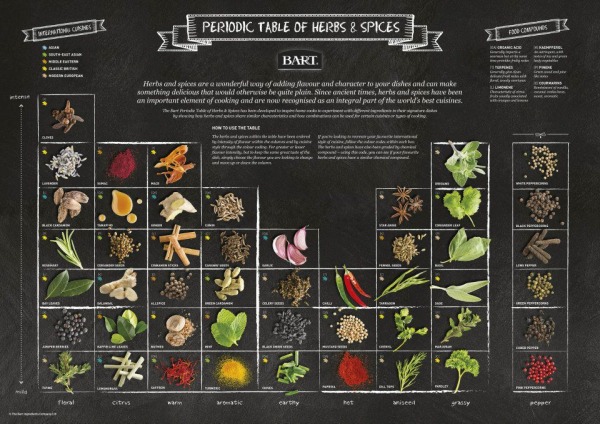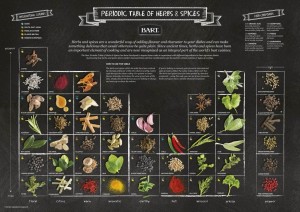Herbs and spices are a wonderful way of adding flavour and character to your dishes and can make something delicious that would otherwise be quite plain. Since ancient times, herbs and spices have been an important element of cooking and are now recognised as an integral part of the world’s best cuisines.
The Bart Ingredients Company know that cooking is more than just a science, but with so many different flavour profiles from herbs and spices all over the world, they understand how easy it can be just to stick to your old faithful ingredients. But just like Mendeleev empowered scientists to understand the chemical elements, Bart wants to enable cooks to truly understand the powers concealed in their spice racks… and so was born the Periodic Table of Herbs and Spices; giving consumers the confidence to be creative cooks in the kitchen.
Introducing The Bart Taste Team
Professor Peter Barham started off proceedings with the crucial task of determining the chemical compounds in each herb and spice. Using scientific literature, he identified the chemicals found in 45 herbs and spices in the Bart Ingredients range and categorised these according to their chemical similarities. By finding the appropriate groupings, it was then possible to represent them in a form similar to that of the Periodic Table of elements. From there followed many debates and discussions with the taste team as they agreed on the intensity of each group, looking at their flavour profile and cuisine nationality.
In 2012 Bart brought together some of Britain’s most refined palates, each to bring their different taste specialities to the table. Michelin Star Chef Will Holland and Master of Wine Mike Ritchie were joined by Bart’s NPD Technologist Rachael Brown, to spend many a long day scrutinising and analysing the herbs and spices in Bart’s range. Together with food writer and historian Dr Polly Russell, molecular gastronomist Professor Peter Barham and Home Economist Lesley Mackley, the team set about to group the ingredients according to their cuisine nationality, chemical compound and flavour profile.
Will Holland, multi-award winning chef at La Bécasse in Ludlow and part of the Taste Team added, “I’m delighted to be involved in such a fantastic project. Herbs and spices are very complex, so it can be daunting to experiment, not knowing which ones will complement and where you can substitute in recipes for it to still taste delicious, just different. I hope that the Periodic Table of Spices can help inspire people to be more adventurous, stretch their knowledge and inspire them back into the kitchen to have fun and explore with different kinds of herbs and spices”
Professor Peter Barham commented, “Herbs & spices can be classified both by the flavour notes they convey and by the various chemical components that dominate their aroma. Once we had organised them into their columns we then looked to rearrange them by strength, allowing for a greater depth of flavour the higher up the table a cook goes. Finally once the chemical similarities had been decided, we arranged the herbs and spices by flavour association grouping them into food nationalities”
How to use the table
The Periodic Table is easy to use, with each column signifying the flavour characteristics of the herbs and spices, and the intensity being shown as you move from top to bottom. Boxes are included in the table to signify the chemical similarities of the herbs & spices and the type of cuisine, allowing consumers to use them as keys to be more adventurous with different herbs and spices whilst still retaining the great and familiar taste of their favourite recipes.
Rachael Brown from Bart commented, “The Periodic Table of Herbs and Spices shows how herbs and spices share similar characteristics and how combinations can be used for certain cuisines or types of cooking. We hope it will inspire home cooks to experiment with different ingredients in their signature dishes and explore exciting new flavour combinations.”
You can download the table from Bart’s Facebook page by clicking here.

